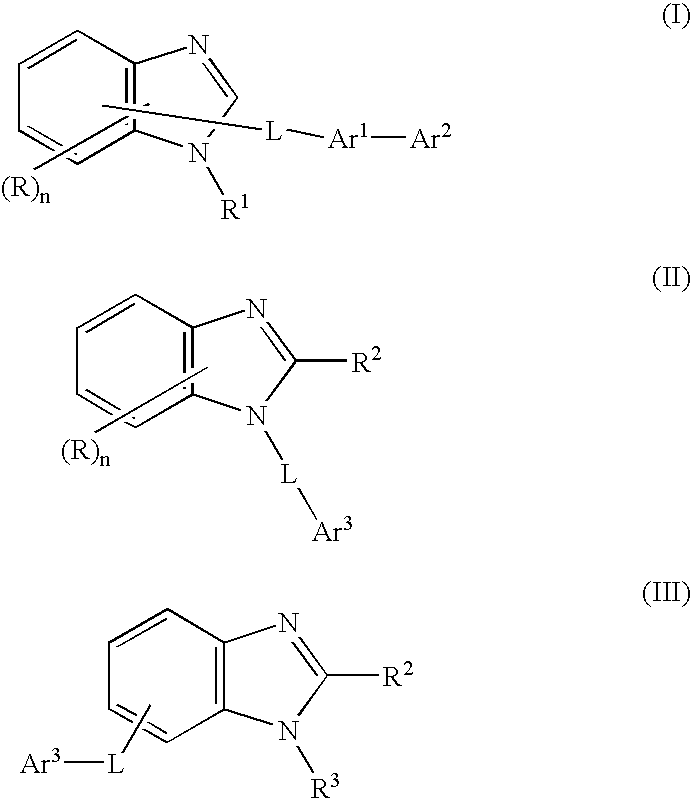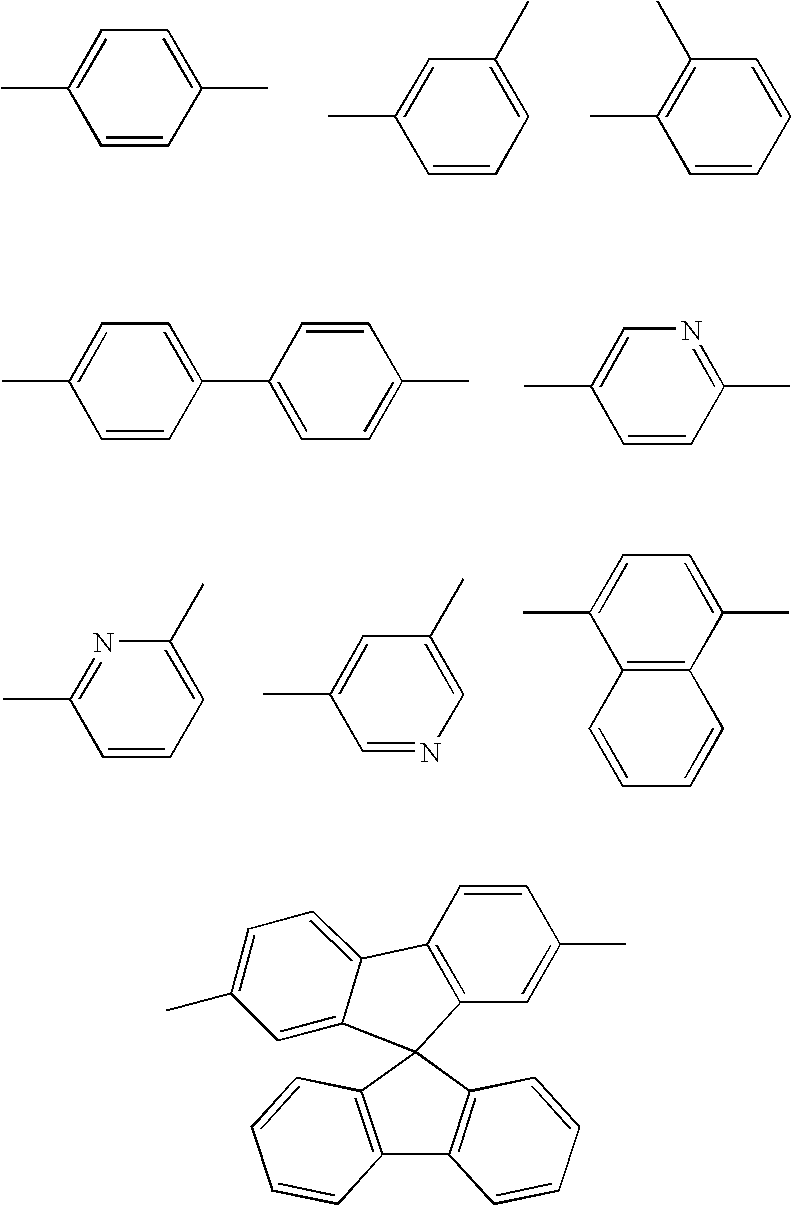Nitrogen-containing heterocycle derivative and organic electroluminescent element using the same
a technology of nitrogen-containing heterocycle and organic electroluminescent element, which is applied in the direction of discharge tube luminescnet screen, other domestic articles, natural mineral layered products, etc., can solve the problems of high driving voltage of conventional organic el devices, only exhibiting low luminance or low light emission efficiency, and not being practicably used, etc., to achieve the effect of increasing the luminance and light emission efficiency
- Summary
- Abstract
- Description
- Claims
- Application Information
AI Technical Summary
Benefits of technology
Problems solved by technology
Method used
Image
Examples
synthesis example 1
Synthesis of Compound (1-7)
(1) Synthesis of 2-(4-bromophenyl)-1-phenyl-1H-benzimidazole
[0084] Suspending 3.0 g (15 mmol) of 4-bromobenzoic acid into 30 milliliter of 1,2-dichloroethane, adding 2.7 g (23 mmol) of thionyl chloride and 3 drops of N,N-dimethylformamide, the resultant solution was stirred with heating at the temperature of about 50° C. for 1 hour and 30 minutes until benzoic acid as the material disappeared. After completion of the reaction, removing the solvent and excess thionyl chloride by distillation, dissolving the resultant acid chloride into 30 milliliter of N-methylpyrrolidone, adding 2.8 g (15 mmol) of N-phenyl-1,2-phenylenediamine, the resultant solution was stirred at room temperature for a night. After completion of the reaction, adding water and filtering the precipitated solid, further washing with water and by drying under reduced pressure, 5.2 g of 4-bromo-N-(2-phenylamino-phenyl)-benzamide was obtained.
[0085] The benzamide was stirred with heating u...
synthesis example 2
Synthesis of Compound (4-2)
(1) Synthesis of 2-(3-bromophenyl)-1-phenyl-1H-benzimidazole
[0087] Almost the same procedure as step (1) in Synthesis Example 1 was carried out except that 3-bromobenzoic acid was employed instead of 4-bromobenzoic acid, 3.8 g of 2-(3-bromophenyl)-1-phenyl-1H-benzimidazole was obtained (yield: 81%).
(2) Synthesis of 2-[3-(10-naphthalene-2-yl-anthracene-9-yl)-phenyl]-1-phenyl-1H-benzimidazole (Compound (4-2))
[0088] Almost the same procedure as step (2) in Synthesis Example 1 was carried out except that 2-(3-bromophenyl)-1-phenyl-1H-benzimidazole obtained in the above step (1) was used instead of -(4-bromo-phenyl)-1-phenyl-1H-benzimidazole, resultantly obtaining 3.7 g of yellowish white solids (yield: 74%). As a result of MS analysis, it was recognized that the yellowish white solids were identified as the aimed substance and that m / e=572 for molecular weight of 572.23.
synthesis example 3
Synthesis of Compound (1-1)
(1) Synthesis of 2-(4-iodophenyl)-1-phenyl-1H-benzimidazole
[0089] Suspending 5.0 g (20 mmol) of 4-iodobenzoic acid into 50 milliliter of 1,2-dichloroethane, added 3 drops of N,N-dimethylformamide. Further adding 3.6 g (30 mmol) of thionyl chloride, the resultant suspension was refluxed with heating for 2 hours. Subsequently, removing the solvent by distillation, the residue was dissolved into 50 milliliter of N-methylpyrrolidone and then, further adding 3.7 g (20 mmol) of N-phenyl-1,2-phenylenediamine, the resultant solution was stirred at room temperature for 5 hours. After completion of the reaction, adding water and filtering the precipitated solid, washing with water and further with methanole, 8.0 g of crude 4-iodo-N-(2-phenylamino-phenyl)-benzamide was obtained.
[0090] Dispersing 4.5 g (11 mmol) of the obtained crude 4-iodo-N-(2-phenylamino-phenyl) benzamide and 0.57 g (3 mmol) of p-toluenesulfonic acid 1 hydrate into 45 milliliter of xylene, the ...
PUM
| Property | Measurement | Unit |
|---|---|---|
| Transport properties | aaaaa | aaaaa |
| Light | aaaaa | aaaaa |
Abstract
Description
Claims
Application Information
 Login to View More
Login to View More - R&D
- Intellectual Property
- Life Sciences
- Materials
- Tech Scout
- Unparalleled Data Quality
- Higher Quality Content
- 60% Fewer Hallucinations
Browse by: Latest US Patents, China's latest patents, Technical Efficacy Thesaurus, Application Domain, Technology Topic, Popular Technical Reports.
© 2025 PatSnap. All rights reserved.Legal|Privacy policy|Modern Slavery Act Transparency Statement|Sitemap|About US| Contact US: help@patsnap.com



